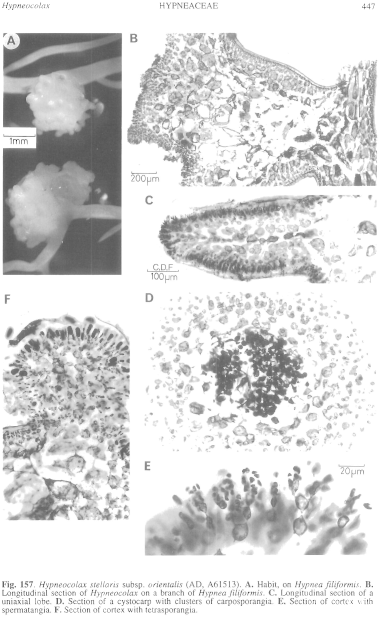|
|
|
|
|
|||||||||||
|
Electronic Flora of South Australia Species Fact Sheet
Phylum Rhodophyta – Class Florideophyceae – Order Gigartinales – Family Hypneaceae
Synonym
Forma orientalis Weber-van Bosse 1928: 393, fig. 143. Dawson 1961: 234, pl. 26 fig. 1. Fan 1961: 119, pls 54–56. Kraft & Woelkerling 1981: 81, fig. 4.1H; 1990: 46, fig. 3.2H. Kylin 1956: 304. Mshigeni 1976: 829, figs 1–4. Segawa 1941: 261, fig. 8.
Thallus (Fig. 157A) white to pale grey-red, 0.2–2 mm high, with a short stalk from the host branch and a head of numerous rounded lobes; parasitic on various species of Hypnea. Structure uniaxial (Fig. 157C), apical cell inconspicuous, cells of the axial filament cutting off usually two periaxial cells, developing a medulla (axial filament not recognisable) of irregular ovoid cells 40–150 µm in diameter, with numerous prominent secondary pit-connections between them and also to the very similar host cells (Fig. 157B); cortex lax, 3–5 cells broad, cells separated, outer cells 4–9 µm in diameter, L/D (1–) 2–4 in sectional view.
Reproduction: Sexual thalli monoecious or dioecious. Carpogonial branches 3-celled, borne on inner cortical cells, with the auxiliary cell next outwards from the supporting cell (Fan 1961); gonimoblast developing a reticulum (Fig. 157D) with the auxiliary cell usually visible more or less centrally or basally, with smaller cells of the reticulum producing clusters of small cells which cut off single, subspherical to ovoid, carposporangia 12–24 µm in diameter. Cystocarps swollen and partly protruding from the lobes, 400–600 µm across, with a pericarp 3–4 cells thick, non-ostiolate. Spermatangia (Fig. 157E) in sori, cut off via initials from outer cortical cells, in short chains, ovoid, 2–3 µm in diameter.
Tetrasporangia in sori (Fig. 157F) in the outer cortex, basally pit-connected, elongate-ovoid, 25–40 µm long and 12–22 µm in diameter, zonately divided.
Type (of f. orientalis) from the Ant Islands, Indonesia; probably in L?
Selected specimens: Garden I., W. Aust., 10 m deep W of causeway, on H. episcopalis (AIMS-NCI, Q66C 2767-X, 20.iii.1989; AD, A59748). Scotts Bay, S. Aust., upper sublittoral on H. episcopalis (Womersley, 27.i.1951; AD, A13929). Masillon I., Isles of St Francis, S. Aust., 4–6 m deep on H. filiformis? (Shepherd, 5.i.1971; AD, A37907). Port Elliot, S. Aust., drift on H. episcopalis (Womersley, 20.i.1960; AD, A23993). Robe, S. Aust., shaded reef pool S of jetty (Womersley, 7.xii.1991; AD, A61513).
Distribution: Tropical to temperate Indo-Pacific [f. stellaris in the West Indies]. In southern Australia, from Garden I., W. Aust., to Robe, S. Aust.
Taxonomic notes: Southern Australian specimens of Hypneocolax appear to agree well with f. orientalis Weber-van Bosse, but the difference between the two "forms" (bi- or tetrasporangia) is certainly of greater degree than that of forms, and the Pacific taxon is here regarded as a subspecies. The species was reported by Goff (1982, p. 297) from Victoria.
References:
BOERGESEN, F. (1920). The marine algae of the Danish West Indies. Part 3. Rhodophyceae. Dansk bot. Ark. 3, 369–504.
DAWSON, E.Y. (1961). Marine red algae of Pacific Mexico. Part 4. Gigartinales. Pac. Naturalist 2, 191–343.
FAN, K.C. (1961). Morphological studies of the Gélidiales. Univ. Calif. Pubis Bot. 32, 315–368.
GOFF, L.J. (1982). The biology of parasitic red algae. Progr. Phycol. Res. 1, 289–369.
KRAFT, G.T. & WOELKERLING, W.J. (1981). Rhodophyta - systematics and biology. In Clayton, M.N. & King, R.J. (Eds), Marine Botany: an Australasian Perspective, Ch. 5, pp. 104–137. (Longman Cheshire: Melbourne.)
KRAFT, G.T. & WOELKERLING, W.I. (1990). Rhodophyta. In Clayton, M.N. & King, R.J. (Eds), Biology of Marine Plants, Ch. 3, pp. 41–85. (Longman Cheshire: Melbourne.)
KYLIN, H. (1956). Die Gattungen der Rhodophyceen. (Gleerups: Lund.)
MSHIGENI, K.E. (1976). New records of Hypneocolax stellaris f. orientalis Weber-van Bosse a parasitic red alga. Nova Hedwigia 27, 829–834.
SEGAWA, S. (1941). New or noteworthy algae from Izu I. Sci. Pap. Inst. Algol. Res. Hokkaido Univ. 2, 251–271, Plates 55–58.
WEBER-VAN BOSSE, A. (1928). Liste des Algues du Siboga. IV. Rhodophyceae. Part 3. Gigartinales and Rhodymeniales. Siboga-Expeditae, Monogr. LIXd, pp. 393–533, Plates 11–16.
The Marine Benthic Flora of Southern Australia Part IIIA complete list of references.
Publication:
Womersley, H.B.S. (14 January, 1994)
The Marine Benthic Flora of Southern Australia
Rhodophyta. Part IIIA, Bangiophyceae and Florideophyceae (to Gigartinales)
Reproduced with permission from The Marine Benthic Flora of Southern Australia Part IIIA 1994, by H.B.S. Womersley. Australian Biological Resources Study, Canberra. Copyright Commonwealth of Australia.
Illustration in Womersley Part IIIA, 1994: FIG. 157.

Figure 157 enlarge
Fig. 157. Hypneocolax stellaris subsp. orientalis (AD, A61513). A. Habit, on Hypnea filiformis. B. Longitudinal section of Hypneocolax on a branch of Hypnea .filiformis. C. Longitudinal section of a uniaxial lobe. D. Section of a cystocarp with clusters of carposporangia. E. Section of cortex with spermatangia. F. Section of cortex with tetrasporangia.

|
Email Contact: State Herbarium of South Australia |

|